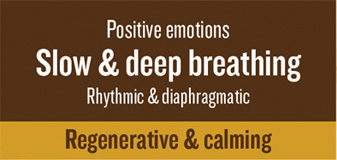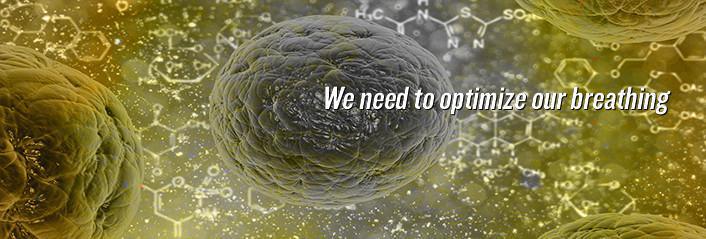Science tells us that well over 80% of population is breathing wrong ... shallow and inefficient ... producing toxic waste products and further promoting dysfunction on a cellular level.
Ultra fast paced & unhealthy modern lifestyle, slowly & through time, deteriorates our breathing habits into rapid shallow chest breathing.

This means we are overbreathing! Instead of optimal 6 breaths we are pulling anywhere from 16 to 20 breaths per minute, while poor breathing technique further decreases overall breathing efficiency.
Overbreathing causes disbalance in oxygen/carbon dioxide gas exchange ... depriving your cells of the needed oxygen and precious energy and this in effect makes your cells sick, makes you sick.
Poor oxygenation is connected to most modern chronic conditions (obesity, asthma and copd, diabetes, burn out, insomnia, obesity, cancer ...)
Studies show that we are breathing faster and less efficient each year!

The alarming statistics!!!
(modern civilization is pushed over the limit)
These are just a few alarming symptoms indicating that modern civilization has pushed us over the limits of our capacity ... by imposing permanent and perpetuating anxiety & stress that results in high levels of a systemic toxicity and burnout.
80% of population is under permanent toxic stress which is one of the leading causes for many modern chronic diseases.
Here is the alarming statistics that proves we have reached our limits!
- Asthma 300 million,
- Chronic pulmonary disease 600 million,
- Diabetes 420 million,
- 17 million/year will die from cardiovascular diseases,
- 15 million/year will die from cancer
- 50 % of population is overeating / obesity pandemics
- 30% diagnosed with insomnia
- almost 1 million suicides per year
Hundreds of research papers have linked stress to poor breathing habits, while all of these modern chronic conditions can be traced back to one single common source of all problems, insufficient cell oxygenation or cell hypoxia.
We can agree that health of every cell is vital for our survival. Scientists are unanimous in agreement that proper oxygenation is one of the most crucial elements of the health of our cells. And healthy cells mean a healthy body as well as a healthy mind.
Your health starts at the level of every cell in your body!
And there is a simple way to achieve that:
just by breathing correctly!
How our lives are connected to cellular oxygenation
The most important aspect of mental and physical health and well-being is the respiratory process. Oxygen is absolutely essential for all human function.
In fact, the primary homeostatic mechanism in the human body is designed around necessitating appropriate cellular oxygenation. The respiratory and cardiovascular systems provide and properly distribute oxygen to the cellular mitochondria where it serves as the terminal electron acceptor in the oxydative phosphorylation process and the formation of cellular ATP.
All human performance, energy, and function is based on appropriate tissue oxygenation. Any disturbance of this supply can be life threatening.
The connection between oxygen and disease
The world famous Dr. Arthur Guyton theorized that all chronic pain, suffering and diseases are caused from a lack of oxygen at the cellular level. Lack of cellular oxygen is termed hypoxia.
Hypoxia has been implicated in central nervous system pathology in a number of disorders including cancer, heart disease, stroke, and various other neuro-degenerative diseases. Among other diseases, regions of low oxygen tension are commonly found in malignant tumors and are associated with increased frequency of tumor invasion and metastasis.
Emotional states directly influence how we breathe
Anger, fear, anxiety - shallow in and out breaths;
Grief - spasmodic breathing;
Guilt - restricted breathing;
Boredom - shallow, lifeless breathing;
Sadness/depression - Under breathing (breath hold)
 |  |
Permanent chronic stress and negative emotions deteriorate our breathing habits into rapid shallow chest breathing.
This in effect produces additional toxic waste products, promoting a wide range of pulmonary & other diseases in our bodies and depression for our mind, contributing to an ever more widely present "burnout syndrome”.
Shallow chest breaths penetrate only into the upper portion of the chest and lungs. This reduces your bodies’ ability to effectively oxygenate.
This is appropriate in order to increase respiratory rate when you are under truly stressful situations, like being chased by a lion or sprinting on a track. However, when it continues for an extended period of time it sets up the pathological processes.
Breathing determines your lifespan
A long-term study found that lung function predicts mortality rates. Dr. Schunemann explains, "The lung is a primary defense organ against environmental toxins. An impaired pulmonary function leads to decreased tolerance against these toxins.
Dr. Wendell Hendricks, (Two-time Nobel Laureate, Winner of the Nobel Prize for Cancer Research, Hendricks Research Foundation) said, "Cancer is a condition within the body where the oxidation has become so depleted that the body cells have degenerated beyond physiological control.
Similarly, the true cause of allergies is lowered oxidation process within the cells, causing the affected individual to become sensitive to foreign substances entering the body.
Only when the oxidation mechanism is restored to its original high state of efficiency can the sensitivity be eliminated.”
Several studies have shown that heart disease, depression, anxiety, and chronic pain patients have an intimate relationship with persistent shallow, chest breathing behaviors.
Many researchers have suggested posture and breathing habits to be the most important factor in health and energy promotion.
Dr. Guy Hendricks says, "Healthy breathing should be the first thing taught to a heart patient. A Dutch Study conducted by a Dr. Dixhoorn, compared two groups of heart attack patients. The first group was taught simple diaphragmatic breathing, while the second group was given no training in breathing.
The breathing group had no further heart attacks, while 7 of the 12 members of the second group had second heart attacks over the next 2 years.”
Proper breathing in addition pumps cerebro-spinal fluid (the fluid around the spinal cord), which results in an increase in brain metabolism and the resulting feelings of physical and mental well-being and enhanced mental alertness.
The body responds to this stimulus by relaxing, understanding that it is not in a life-threatening situation (obviously if you are breathing long, slow, deep breaths you are not being chased by a lion).
The parasympathetic nervous system is activated, calming stress hormones, decreasing heart rate and blood pressure.



